The parallel price thus registered its fourth consecutive decline and is heading to close another week with declines.
The blue it had risen strongly in the second week of November to a maximum of $ 172, before the reappearance of demand, which found no support in the genuine supply. However, for four weeks it has been going down uninterruptedly.
Among the factors that contributed to this bearish scenario for blue, analysts and traders point to the official intervention in the markets of Dollars financial, the bond tenders launched by the Ministry of Economy (where the demand for the bono dollar linked tied to the evolution of the official price), and fiscal and monetary signals, such as the adjustment in Transient Leads from the Central Bank to the Treasury, at least until December.
The combination of measures and greater power granted by President Alberto Fernández to Minister Martín Guzmán, managed to defuse, at least for the moment, the exchange rate and financial tension.
Official market
Against the blue, the official price of the dollar rose 46 cents in the average of the public and private banks of the city of Buenos Aires.
The average retail exchange rate reported by the Central Bank was in the $ 87.84 for sale, 0.5% more than yesterday.
This rise brought the “solidarity” exchange rate, which includes a 65% tax pressure, to $ 144.94 in the average of the banks.
On the stock market, for its part, the MEP dollar fell 1.1% to $ 138 and the cash with settlement fell 1.3% to $ 141.
–


